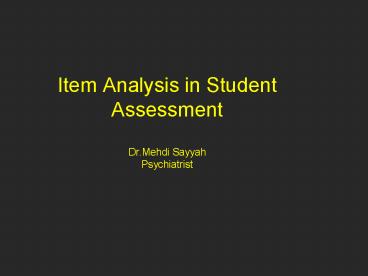Item Analysis in Student Assessment Dr.Mehdi Sayyah Psychiatrist - PowerPoint PPT Presentation
1 / 21
Title:
Item Analysis in Student Assessment Dr.Mehdi Sayyah Psychiatrist
Description:
Title: Title Author: Dr. Shahram Yazdani Last modified by: ahvazi Created Date: 10/5/2003 4:47:09 PM Document presentation format: On-screen Show (4:3) – PowerPoint PPT presentation
Number of Views:153
Avg rating:3.0/5.0
Title: Item Analysis in Student Assessment Dr.Mehdi Sayyah Psychiatrist
1
Item Analysis in Student AssessmentDr.Mehdi
SayyahPsychiatrist
2
Item/Question Analysis
- Rank total scores in descending order for total
group - Divide into two groups HIGH and LOW group,
normally about 25 both ways (Optimum27)
3
Facility Index (FI)
- Defined as proportion in total group getting the
item right - If everybody in the group got the item right, the
facility index (FI) 1 indicating a very easy
item - If everybody in the group got the item wrong, the
facility index (FI) 0 indicating a very
difficult item. - Hence FI ranges from 0 to 1, the higher the
value, the easier is the item.
4
Discrimination Index (DI)
- Defined as the proportion in the HIGH group
getting the item right MINUS the proportion in
the LOW group getting the item right. DI pH-pL - If everybody in the HIGH group got the item right
and everybody in the LOW group also got the item
right then DI pH-pL 1 1 0. The item has
zero discrimination index. It is not
discriminating at all! - If everybody in the HIGH group got the item right
and everybody in the LOW group got the item
wrong then DI pH-pL 1 0 1. The item has
positive 1 as DI, maximum discrimination which
is ideal in the norm referenced sense.
5
Discrimination Index (DI)
- If everybody in the HIGH group got the item wrong
and everybody in the LOW group got the item
right, then DIpH-pL 0 1 -1. The item has
negative 1 as DI, maximum discrimination in the
wrong direction. Bad in the norm-referenced
sense. - Hence DI ranges from 1 to 1, where negative
values indicate discrimination in the wrong way
but positive values for DI, indicate good
discrimination. The higher the value of DI, the
better or more discriminating is the item.
6
Approximate Values for FI and DI
- In a class of about 40 students, take the first
10 as the HIGH group and the bottom 10 as the
LOW group. - Then FI is approximately equal to
- (pH pL)/2.
- Then DI is pH - pL
7
Matrix of student data on a twenty-one item test
8
- The data for the student with lowest score was
entered first, then the student with the next
lowest score, and so on.
9
Students divided into three groups according to
score
10
- The position of the rows (item scores) has been
altered so that the easiest item is at the top of
the matrix and the other rows are arranged in
descending order. Notice that the top right
corner of the matrix has mostly entries of 1s,
and the lower left corner has mostly entries of
0s.
11
- The students have been assigned to 3 (equal)
groups. The highest 6 scorers will be called the
High group the lowest 6 scorers will be called
the Low group the Middle group of 6 has been
shown underlined. (Note that to form three groups
of equal size, the middle
12
- We can investigate the patterns of success for
each item (in an approximate way) by graphing the
success rate of the Low group and the
corresponding success rate of the High group.
13
Correct answer responses for item 1
14
Correct answer responses for item 4
15
Correct answer responses for item 19
16
- Now we return to considering the middle group.
(If the middle group was not exactly the same
size as the low and high groups,
17
Correct answer responses for L, M and H groups on
items 1, 4, 19, and 21
Item 1
Item 4
Item 19
Item 21
18
Acceptable and may be acceptable correct answer
response patterns
19
Unacceptable correct answer response patterns
20
Patterns for correct responses
21
- Thank You !
- Any Question ?































